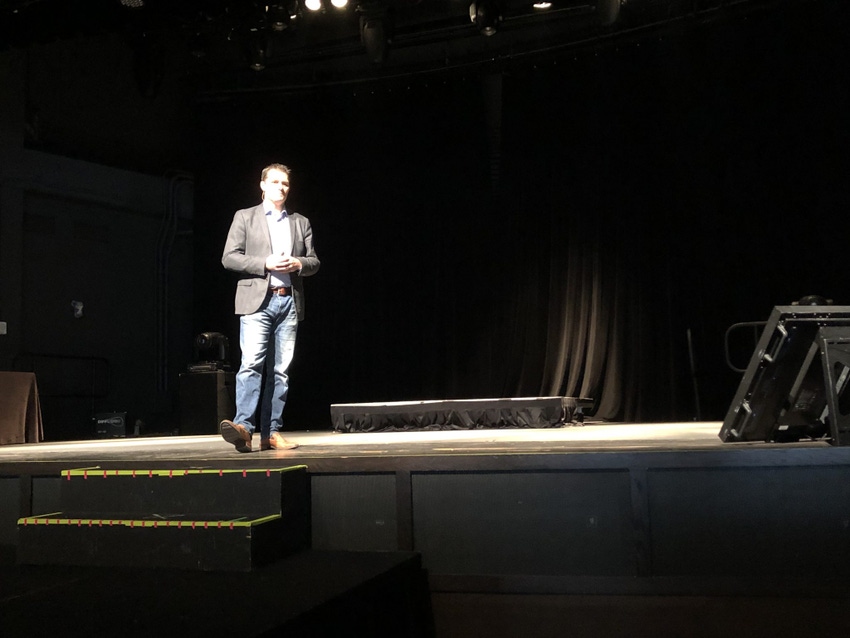E-commerce is making its mark on B2B technology.

(Pictured above: Forrester’s Jay McBain on stage at the Wildix UC&C Summit in Dallas, Feb. 4.)
WILDIX UC&C SUMMIT — Direct technology sales will grow faster than indirect in 2020 for the first time in four decades, according Forrester’s Jay McBain.
McBain, who serves as principal analyst of channel partnerships and alliances for the research firm, said the approximate $2.26 trillion of channel spend accounts for 64% of all technology spend.
“That 64% has been growing for 39 years, and now we’re seeing it kind of level off, ” McBain told an audience of Wildix partners Tuesday. ” And there’s a bunch of reasons for that.”

Forrester’s Jay McBain
The meteoric rise of public cloud providers (Google Cloud just reported 53% growth) and consistent growth of SaaS providers like Salesforce does spell revenue for channel partners, but McBain said a larger share has gone through marketplaces and other direct routes.
McBain encouraged partners to explore how they can potentially join a marketplace. Forrester predicts that e-commerce will account for 17% of B2B sales within three years.
“We’re talking about a couple trillion dollars; it’s going to move out of a traditional means, into marketplaces,” he said.
McBain shared several data points and trends, and an important one to note is how the customer is changing. For example, different lines of businesses are getting getting involved. Nontraditional parties account for two-thirds of business technology purchases.
“The head of marketing in many companies spends more money on technology than the CIO,” McBain said. “If you look at who’s firing up call centers, it’s inside sales teams. Whether they report to the sales leader or the marketing leader or the CRO, it’s these types of people are buying UC, who are looking at different ways to work with customers, who are looking at the different customer moments and all the different touch points.”
McBain: The data shows that more and more C-level execs and departments other than the CIO and the IT are making tech purchasing decisions:
“Shadow IT turned into the new normal.”#UCCSummit pic.twitter.com/f6aS6TweL7— James Anderson (@JamesAndersonCP) February 4, 2020
McBain also touched on the aging nature of the traditional channel. The number of IT channel firms has dropped 36% since 2008, and 40% of channel owners say they will retire by 2024, according to CompTIA research. Moreover, millennials will account for 75% of the channel in four years. While some channel owners may want to pass the business onto their children, the next generation may not be on board with that plan.
“The kids don’t want to take over the business. It’s not this idea where it’s passed generationally, because the kids don’t want to pull cables. Kids don’t want to fix printers and do stuff with server rooms. They’re out doing other things,” he said.
That’s not to say millennials aren’t interested in selling indirect technology. Check out the Salesforce Dreamforce conference, and you’ll find hordes of young people who are working to deliver outcomes to specific line-of-business buyers. McBain has previously outlined the “shadow channel,” which contains vertical-specific professional services firms and digital agencies, emerging tech startups and independent software vendors.
The analyst also encouraged partners to reflect on the statistic 68% of buyers would rather do their own research. For channel partners, this means shifting from “hand-to-hand combat” sales approach to a layered approach. Is your company building and presenting the informational content needed to set itself up as an influencer? Are you forming alliances with companies who could bring you into a deal?
“In your customer and in your prospects, what does that 68% look like and how do you influence that? Because you’re not going to be in the room. You won’t be one of the five in the room in every scenario,” McBain said. “But you could be in the room, if one, two, three or four of those people are representing you and their solution is built on top of yours, or yours is adjacent to theirs. One plus one equals three.”
McBain was speaking at the Wildix 2020 UCC Summit, where the vendor shared its channel strategy on Monday. You can read his 2020 predictions piece on the Forrester website.
McBain on how cloud, #IoT, AI and automation are becoming leading business tech investment targets: “Emerging [tech] isn’t emerging; it’s here.” #UCCsummit pic.twitter.com/V1LLYFoM6u
— James Anderson (@JamesAndersonCP) February 4, 2020
Read more about:
AgentsAbout the Author(s)
You May Also Like


